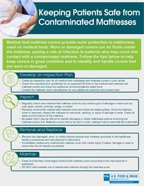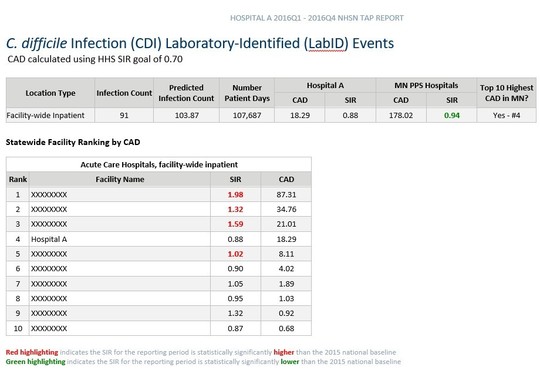|
In case you missed it- Kerri Miller, MPR News host, led a discussion on the best practices in prevention of healthcare-associated infections. Dr. Dimitri Drekonja, Associate Professor of Medicine at the University of Minnesota, and member of the Infectious Disease Section at the Minneapolis VA, and Dr. Arjun Srinivasan, Associate Director for Healthcare-Associated Infection Prevention Programs at the CDC presented best practices in infection control and how both patients and staff can prevent the spread of antimicrobial resistant bacteria.
Topics such as cleanliness of the room, hand hygiene, and the importance of consistently following established protocols to prevent and control the spread of multidrug resistant bacteria in hospitals are covered along with testimonials from patients about their experiences in local hospitals.
Listen in: How to protect yourself from infection when you go to the hospital
 Is it a single dose vial? Is it a multi-dose vial? Single dose vials do not have an antimicrobial/preservative. It is not safe to enter the vial with a syringe and needle more than once. A multi-dose vial does have an antimicrobial/preservative. It is safe to enter the vial multiple times for multiple patients, however it is recommended that multi-dose vials be assigned to a single patient when possible. Vials come in a variety of shapes and sizes; do not assume a vial is multi-dose or single dose based on the size. Always read the label three times. Keep your injections safe for patients.
Learn more: The CDC has created an interactive info-graphic to be used for training to demonstrate the difference between single-dose and multi-dose vials: Single-Dose or Multi-Dose? Make all injections safe!
|
 FDA recently issued new recommendations to help facilities ensure bed mattress covers are safe for use in health care settings.
- Mattress covers provide outer protection to a mattress by preventing blood and other body fluids from entering the inside (inner core) of the mattress.
- Over time, hospital bed mattress covers can wear out and allow blood and body fluids to penetrate and get trapped inside mattresses.
- If blood or body fluids from one patient penetrate and get absorbed in a mattress, the fluids can leak out the next time the mattress is used.
- Coming into contact with these fluids poses a risk of infection to patients using the bed.
Learn more: Covers for Hospital Bed Mattresses: Learn How to Keep Them Safe
|
The Targeted Assessment for Prevention (TAP) strategy was developed by the CDC to use NHSN data for action to prevent Healthcare Associated Infections (HAIs). TAP reports also allow health departments and the CDC to prioritize facilities with high HAI burdens.
TAP Reports and CAD
The burden of HAI within facilities and units can be prioritized using a metric called the cumulative attributable difference (CAD), which is equal to the number of infections that must be prevented to achieve a goal Standardized Infection Ratio (SIR). TAP reports allow for the ranking of individual unit locations for the CLABSI and CAUTI measures by the CAD to help prioritize prevention efforts.
TAP reports are available on the NHSN home screen dashboard or through analysis reports. Hospitals can request a TAP report from MDH (see below) that incorporates facility-level data, statewide aggregate data, and the facility's statewide ranking by the CAD metric.
 TAP Facility Assessment
Once a facility has identified a specific type of HAI and/or unit to target, it can administer the TAP facility assessment, a short survey completed by a variety of facility staff. The TAP facility assessment aims to capture staff awareness and perceptions related to HAI prevention policies and practices. Assessments are currently available for CLABSI, CAUTI, and CDI in the acute care setting. Results from the assessment are aggregated into a TAP Feedback Report which identifies key leading and lagging areas, as well as deep dives into top opportunities for improvement. MDH can assist facilities by collecting completed assessments, aggregating results, and generating the Feedback Report. Staff from the ICAR team (see below) are available to assist facilities in using the TAP Feedback Report to address identified opportunities for improvement.
ICAR
Infection Control Assessment and Response (ICAR) is a CDC-funded program developed to strengthen partnerships between the state health department and facility infection preventionists. The ICAR team can provide further assistance with HAI reduction efforts. Following enrollment in ICAR, a Nurse Specialist will perform a voluntary, non-regulatory, no cost on-site visit to discuss priorities and challenges in regards to the infection prevention and control program. After the on-site visit the ICAR team will provide a facility specific report including resources to assist in addressing identified priorities, ongoing consultation and educational needs.
Learn more: For general information about the TAP strategy and CDC's resources, visit: The Targeted Assessment for Prevention (TAP) Strategy; for information about ICAR visit: About the Infection Control Assessment and Response Program (ICAR); for more information about the TAP strategy or to request a TAP report for your facility, contact the MDH HAI Unit at 651-201-5414, 1-877-676-5414.
This is our top 10:
- People stay home from work when they are sick.
- Hand hygiene is always practiced because a super reminder and monitoring system is in place that encourages staff to wash their hands, and hand sanitizer is installed in convenient locations.
- Vaccination rates go up for staff, patients and residents.
- Healthcare-associated infection rates go down.
- Antibiotic resistant organisms lose the battle.
- When patients transfer from facility to facility, Electronic Medical Records Surveillance Systems (EMRs) alert the facility of infectious status and pending tests.
- Electronic Medical Records are built to automatically pull the data needed to report infection status and antibiotic use.
- Everyone covers their cough.
- Staff follow injection safety practices- One Needle, One Syringe, One time, All the time!
- Personal Protective Equipment (PPE) and isolation practices are always
used when caring for patients with potentially
infectious disease.
Travel history, current
outbreaks, and
disease transmission are
considered when precautions are determined.
|